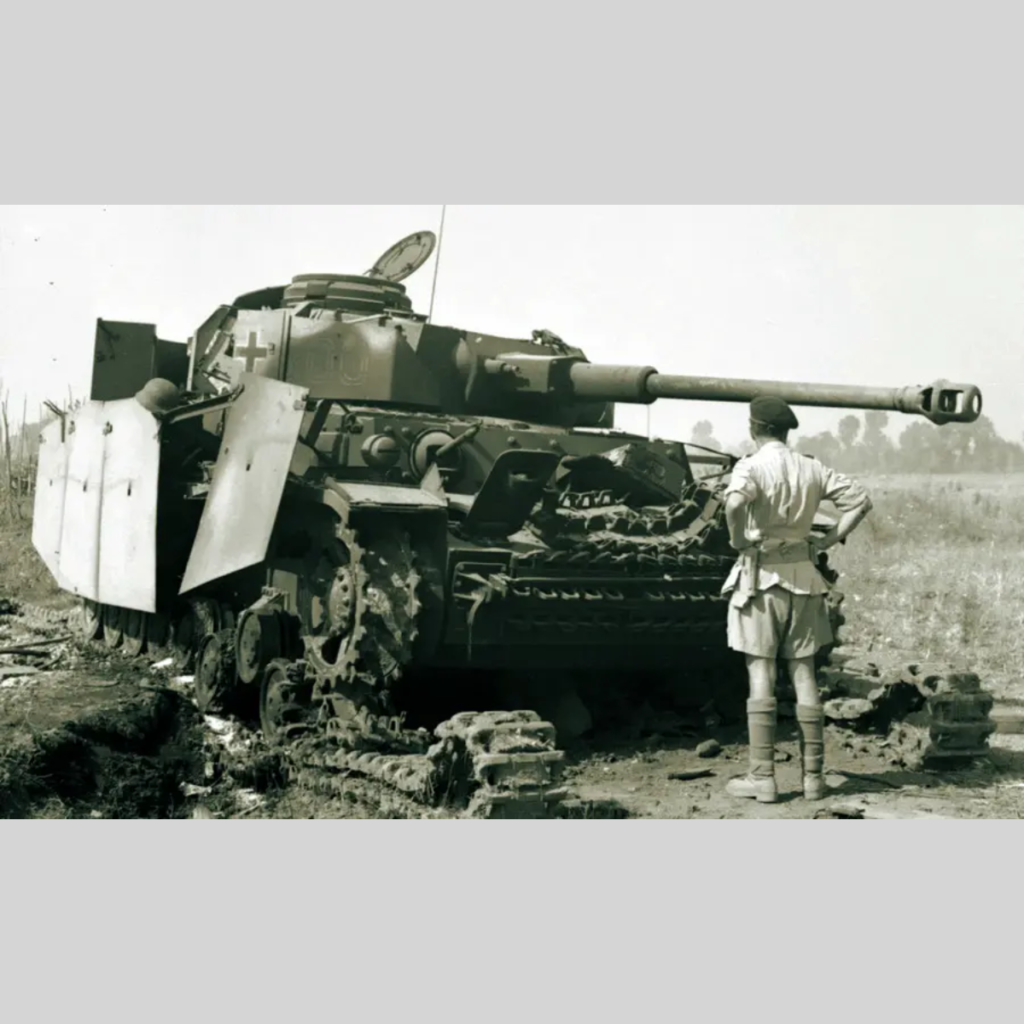
The German Pz.Kpfw. IV began its career as an auxiliary vehicle. It was intended to be a support tank to the main German medium tank Pz.Kpfw. III. However the Panzer III lost the main tank label quite quickly, it turned out the 5cm KwK 39 gun wasn’t enough to fight the new Allied tanks, and the more powerful 7.5cm KwK 40 L/43 didn’t fit the turret. The Panzer IV Ausf. G modification was equipped with this formidable gun, changing the fate of the Panzer IV – it became the main medium tank of the German army. However, the British, Soviet and American tanks developed rapidly, and the German designers had to constantly lookout for new solutions in order to maintain the combat effectiveness of the Panzer IV.
From Africa to Europe
An extensive report by British specialists about the ‘new’ Panzer IV ‘Special’ was published in August 1943. More than a year had passed since the advent of tanks with 7.5 cm KwK 40 at the frontline, and in the conditions of rapid technological advancements in wartime, this was an eternity. British intelligence didn’t miss the fact that the tank was no longer ‘special’. It didn’t take long for the Panzer IV with long-barrelled guns to become widespread and common on the battlefield, and in updated German technical documents, the Panzer IV wasn’t listed as the main medium tank anymore.

Panzer IV sketch from Tactical & Technical Trends. The designation ‘Special Four’ had been dropped by 1944.
Allied forces were fighting different tanks in Italy from what they had previously in Africa. By the end of 1943, intelligence reported that the Germans began to install 6mm non-armoured steel plates on the Panzer IV. The British experts decided that this spaced armour was installed for protection against sub-calibre rounds.
It was also noted that a tank with a long 7.5 cm gun was externally difficult to distinguish from the Tiger since the new extra plates gave the turret a round shape. According to experts, the Germans could have done this on purpose. On some panels, a thin layer of Zimmerit coat was also applied and it was assumed it was intended to protect against anti-magnetic mines or to further mask the vehicle. The Zimmerit coat was something the British were very interested in, they tested similar materials until 1946, but in the end, they never found a real application for it.
The Pz.Kpfw. IV extra panels remained the main topic of discussion in reports until the Spring of 1944. It was noted they didn’t help much against armour-piercing rounds, but they worked effectively against sub-calibre rounds. Unfortunately, it wasn’t possible to establish the effectiveness of side panels, since there wasn’t a single vehicle on which these survived. Scouts reported that these panels were being plundered by infantry on both sides for the construction of makeshift fortifications and furnaces.
In a report, the British mentioned that due to the limited use of tanks by the German in Italy, most of the information about new enemy armoured vehicles came from the USSR. Another reason for the scarcity of information about was quite simple: Germans were using Tiger, Panther and Elephant tanks in significant numbers in Italy, the old Pz.Kpfw. IV was not something outstanding, especially due to the fact the vehicle didn’t radically change its appearance for quite some time.
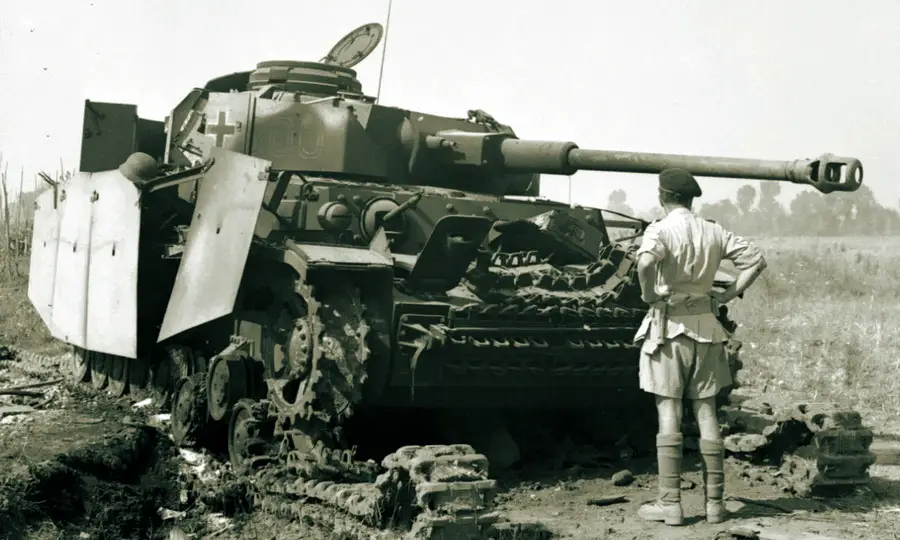
British Officer examines a burnt-out Pz.Kpfw. IV Ausf. H in Italy, September 1943. A rare sight: the tank has a complete set of side-panels. An open hatch of the new commander’s cupola design is also visible.
The following text eloquently indicates how British intelligence was reporting the Pz.Kpfw. VI – “The Pz.Kpfw. IV is still encountered in the frontline. Further comments are unnecessary.”, “Despite large numbers of Tiger and Panther tanks, the Pz.Kpfw. IV remains the German standard vehicle within its divisions.”. The installation of a new gun exhausted all the possible modernization capabilities of the tank, meaning there wasn’t anything new for scouts to report.
The Last “Four”
Battles in Normandy were carried out using a large number of tanks and other armoured vehicles, this gave a whole new array of information about German vehicles gained from both inspection of wrecked vehicles and captured documents. The British soon learned about a new type of Pz.Kpfw. IV equipped with a 48-calibre gun, instead of the old 43-calibre. British experts doubted that such a slight elongation would have any significant effect in the gun ballistics.
It became noticeable that older tanks were also being modernized, as the British found a Pz.Kpfw. IV with a long 7.5 cm gun, but having only 30 mm frontal armour with an additional 30 mm plate – this was used on the older Pz.Kpfw. IV Ausf. D. Another tank with a single 60 mm frontal armour plate was also examined, but it wasn’t clear if the examiners made a mistake: it could an Ausf. G with 50 mm frontal amour or an Ausf. H with 80 mm. Judging by the documents captured, the Panzer IV was being gradually replaced as the main German medium tank with the Panther. The task of the Pz.Kpfw. IV was now to cover the vulnerable sides of the Panther and other tank destroyers.

Upgraded Pz.Kpfw.IV from the Tank Museum collection in Bovington. The vehicle has the Ausf. D characteristic of the hull and turret armour upgrade, but with a 7.5cm long-barrelled gun and shield panels on the turret.
As no documents were found in the wrecked tanks, the official name of the new Panzer IV wasn’t known for a while. The new tank was given the name Pz.Kpfw. Ausf. H, but the British weren’t sure of this, even after the captured vehicle arrived at the School of Tank Technology. In December 1944, a preliminary report was issued, but by that time the Allied forces had plenty of encounters with the new tank, and the captured tank in the hands of the British experts confirmed what they guessed before.
The most noticeable modifications compared to the previous model were the longer 7.5 cm KwK 40 L/48, a new commander’s cupola and the installation of spaced armour on the tank. The thickness of the new commander’s cupola changed; it was increased from 95 mm to 100 mm compared to the Ausf. E, it also had a single-piece hatch with a diameter of 480 mm and a thickness of 12 mm. Unlike the Ausf. G, the cupola lacked a turret turn indicator. The main armour of the vehicle remained the same compared to an Aufs. G, with the exception of a solid 80 mm front plates on the hull and superstructure.
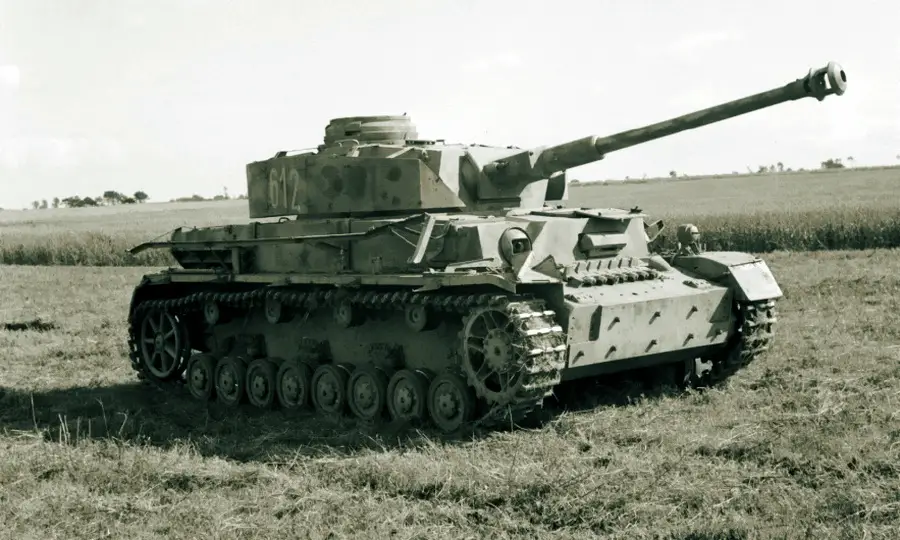
Pz.Kpfw.IV Ausf.H from the 27th Panzer Brigade, captured by the British, Normandy, July 1944.
This time the vehicle supplemented by spaced armour installed on the sides of the hull and around the turret. The thickness of the panels installed was between 5 to 9 mm, a distance of up to 400 mm separated them from the main armour. The turret panels had hinged flaps so that the crew could use the side turret hatches. There were no panels installed on the hull, but the mounts for them were still in place. The panels also had an anti-magnetic coating, but at this time the British intelligence had already learned it was called Zimmerit, so they knew what they were dealing with.
The new L/48 gun was longer than its predecessor L/43, 3610 mm versus 3230 mm. This increased the shell velocity to 790 m/s, but the British experts didn’t compose a new penetration table, having decided that the L/48 compared to the L/43 didn’t change radically. The L/48 gun changes weren’t just limited to its length, the L/48 had a straight cut with a slope of 7°, in contrast to the progressive slope cut of 6 to 9° in the L/43. The rifling and muzzle brake was also different, and some simplifications of the breach were also noted by British experts.
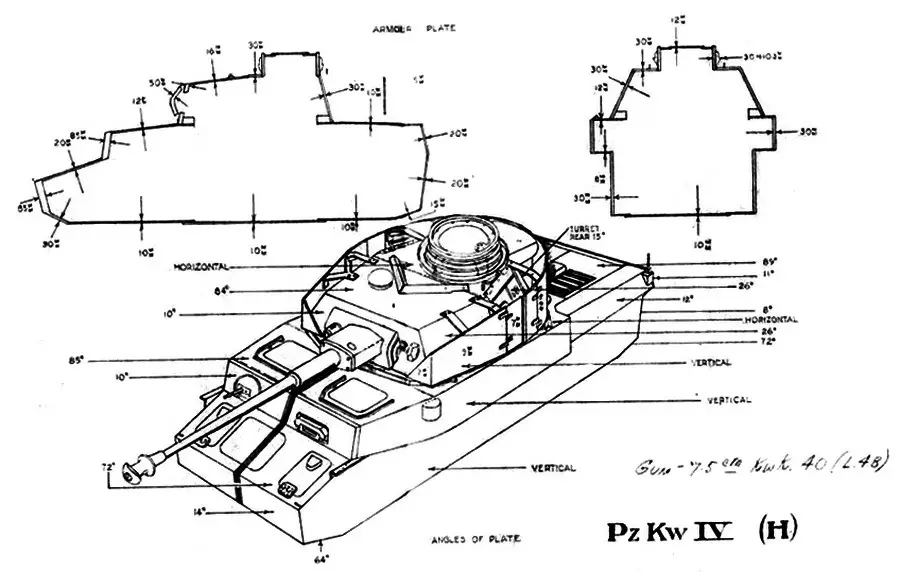
Armour thickness and angles of the Pz.Kpfw.IV Ausf. H.
All the changes made the gun a little heavier, from 472 to 496 kg. The balancing spring was replaced by a hydropneumatic mechanism, a clinometer mount was also added to the cradle. The trigger remained the same, but this time there was no battery mount. The E.M.F. electric generator was present in the tank, same as on the Panther and the ammunition consisted of 85 rounds for the main gun and 1,950 for the two MG 34 machine guns.
Other small changes were also noted, the support rollers were now made of steel, without the rubber tyres, the suspension travel limiters were simplified compared to those used on the Ausf. G and the drive wheel was also different. Since the tank was faulty, no tests were performed.
In the fall of 1944, intelligence reported a new Pz.Kpfw.IV Ausf. J. Later, they managed to capture documents from which they learned about a new commander’s version of the Pz.Kpfw.IV Ausf. H and Ausf. J. These vehicles weighed 24.1 tons, their armament didn’t differ from the regular Panzer IV, but the ammunition was only composed of 20 high-explosive fragmentation shells. On the turret roof, there was a smoke mortar installed.
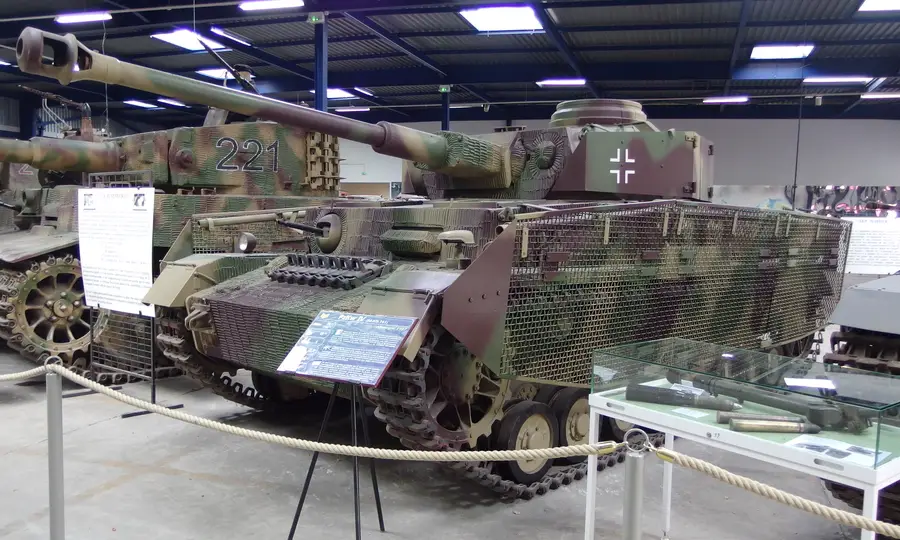
Pz.Kpfw.IV Ausf. H from the Saumur tank museum collection. The vehicle is equipped with lightweight spaced armour, typically for the Pz.Kpfw.IV J.
In the Spring of 1945, a new vehicle designated Pz.Beob.Wg.IV Ausf.J (Panzerbeobachtungswagen) was captured by the American forces and inspected in Belgium. The inspection revealed the vehicle was similar to the Pz.Kpfw.IV Ausf. J, since there wasn’t much difference between them. The armour of the tank didn’t differ from the Pz.Kpfw.IV Ausf.H, even the mounts of the lightweight spaced armour made of steel mesh were absent in this instance, instead of them there were mounts for the first version of spaced armour.

Pz.Kpfw.IV Ausf. H from the Overlord Museum collection. The door in the turret side screen for using the turret side hatch and the commander’s hatch are both open. The tank lacks not only the hull spaced armour but also the mounts for them.
The Panzerbeobachtungswagen was, in fact, an artillery observation vehicle built on the Panzer IV chassis. The tank was equipped with new radio equipment and electrical generator, installed in the left rear corner of the fighting compartment. The antennas were arranged at the rear of the turret. The tank also had mounts for the commander’s periscope, similar to the one used on the Panther. Panzerbeobachtungswagen was intended to work in cooperation with Wespe and Hummel self-propelled artillery.
Behind lines of a defeated enemy
After the war, the British military visited the German factories Krupp and Dortmund-Hörder Hütten-Verein in the territory occupied by the Western Allies. These visits allowed to answer many questions that British experts asked themselves during the study of armour and welding of the hulls of German tanks. It turned out that the changes in the assembly of Pz.Kpfw.IV, began back in March 1942, with the objective to increase the production of vehicles. To simplify the design, even the joints of the front plates were changed – the British believed this was done in order to strengthen the armour. The German designers explained that with the frontal sloped armour thickness of 20 mm the plate was pushed into the hull when hit by a shell in any case, no matter the type of joint.
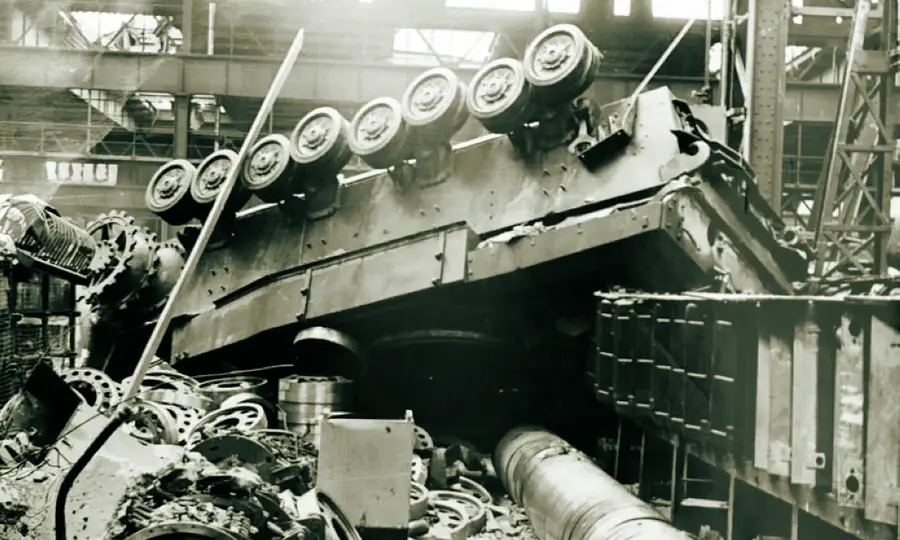
Pz.Kpfw.IV hull at the Nibelungenwerk plant. The Allied strategic bombing had both direct and indirect influence on the output of German armoured vehicles
The new armour joints gave one noticeable advantage: welding became less time-consuming and better. According to employees of both companies, problems with weld cracks were not observed until January 1944, when the transition to new electrodes dramatically reduced the welding quality. Workers had to spend a lot of time re-joining cracked joints.
The quality work also fell due to bombing since by the Winter of 1944, the heating system in both plans stopped working. The armour plates that arrived at the plants were left in the cold for about two weeks, which led to the propagation of cracks. Another factor was the involvement of foreign citizens, prisoners of war and German prisoners in the welding process. Manufacturers simply had other priorities, Dr Vazmakht, Head of the Quality Department at DHHV, answered during interrogation that his main goal was production volume, and the plant was not required to get 100% quality work.

The ‘bath’ of the Pz.Kpfw.IV hull at the Krupp factory.
The fate of the Pz.Kpfw.IV was decided by June 1944. It was impossible to increase the armour thickness and even the most advanced versions of the Panzer IV could be penetrated by the British 6-pounder from 1,400 meters. An armour-piercing projectile of the more powerful 17-pounder could penetrate the Panzer IV armour from 2,000 meters even at an angle of 30°. American vehicles also had something to counter the Panzer IV: a 76 mm gun that could penetrate the Panzer IV frontal armour from 1,650 meters.
The gun of the German tank was also outdated for a long time, in the table “Main tank Guns and their shells”, compiled by the Americans for the British in the fall of 1945, the 7.5 cm KwK 40 L/48 is missing. It’s not surprising that the Germans wanted to completely replace the Panzer IV in favour of the Panthers, but the ‘support tank’ remained in service until the very end of the line with the end of the war in May 1945.